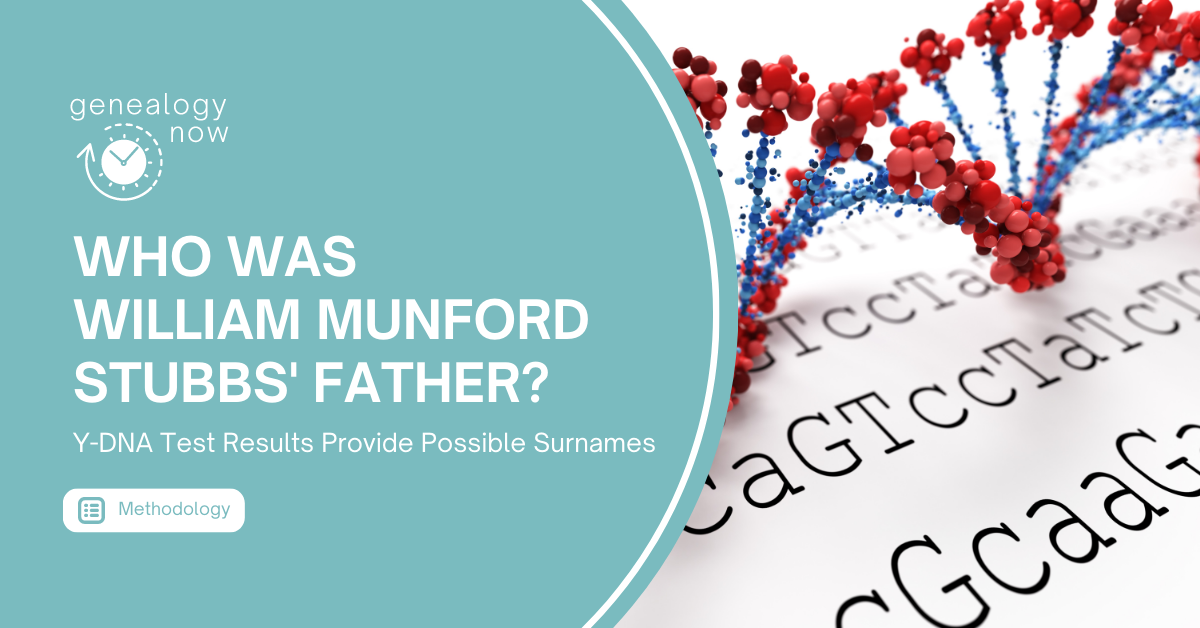
In my last blog post, I introduced my research project for the Research Like a Pro with DNA study group that I participated in over the last three months. William Munford Stubbs was born to single mother Ann Munford. Records indicate that he used his mother’s surname Munford until about 1880, when he suddenly began using the surname Stubbs. Having the results of a Y-DNA test could point to a surname for William Munford Stubbs’ father, which could then be used in further DNA analysis and documentary research.
Y-DNA is passed down almost unchanged from father to son for many generations. FamilyTreeDNA offers Y-DNA tests that can help test takers learn more about their paternal line. Y-DNA test results for one of William Stubbs’ great-great-grandsons revealed five matches at 111 markers with two surnames: Dale and Brock. 1 The closest DNA match has a genetic distance of four at 111 markers and carries the surname Dale. FamilyTreeDNA offers a time predictor (the FTDNA TMRCA tool) that estimates when the most recent common ancestor (MRCA) between two matches might have occurred. With a genetic distance of four, the TMRCA tool predicts that the MRCA would have been born around 1700 (range: 1500-1850). 2
The earliest known ancestor for this Y-DNA match was Nicholas Dale, who was born in Yorkshire, England, in 1604 and died in Virginia in 1646.3 With a family who immigrated to America over two hundred years prior to William’s birth in England, it is likely that the MRCA for the test taker and this YDNA match falls into the earlier part of the possible range for a common ancestor.
Finding the common ancestor using documentary evidence could be a long and involved process. However, tracing families with the Dale or Brock surnames who lived near the Munford family in Wymondham might reveal patrilineal descendants who could be invited to take a Y-DNA test to see if they are closer matches to the test taker.
One important thing to keep in mind is that William’s father may not have carried either surname. This could happen due to what is known as a Non-Paternity Event, which is defined as “any event which has caused a break in the link between an hereditary surname and the Y-chromosome resulting in a son using a different surname from that of his biological father.”4 William Munford Stubbs is a great example of a Non-Paternity Event, using the surname of his unwed mother for the first two decades of his life and a surname of his own choosing after that.
Keeping this limitation in mind, I moved forward with a hypothesis that William’s father’s surname could have been Dale or Brock. In my next post, I will discuss the process I used to identify families with the Dale or Brock surnames who lived near the Munford family in Wymondham. In subsequent posts, I will discuss how I used the autosomal DNA test results for three different test takers to seek paternal candidates with the Dale, Brock, or other yet-to-be-identified surnames.
Have you ever used Y-DNA to help solve a genealogical question? I would love to hear about your experience! Leave a comment below.
- “Y-DNA Matches for [Private Test Taker],” DNA matches at the Y-111, Y-67, and Y-37 Test Levels, FamilyTreeDNA (https://www.familytreedna.com/my/ydna/matches/detail-view : accessed 23 February 2023).
- “Most Recent Common Ancestor Time Predictor based on Y-STR Genetic Distance,” FTDNA Tip Report for [Private Test Taker], who matches [Private Y-DNA Match] at a genetic distance of four on 111 markers, time prediction 1700 CE (1500-1850 CE), FamilyTree DNA (https://ftdna.com : accessed 21 February 2023).
- FamilySearch (https://www.familysearch.org/tree/person/details/MGK7-MR5 : accessed 22 May 2023), database, profile for Nicholas Edward Dale, PID #MGK7-MR5.
- “Non-paternity event,” International Society of Genetic Genealogy Wiki (https://isogg.org/wiki/Non-paternity_event#:~:text=Non%2Dpaternity%20event%20is%20a,that%20of%20his%20biological%20father. : accessed 22 May 2023).

Thanks for your insights on Y DNA